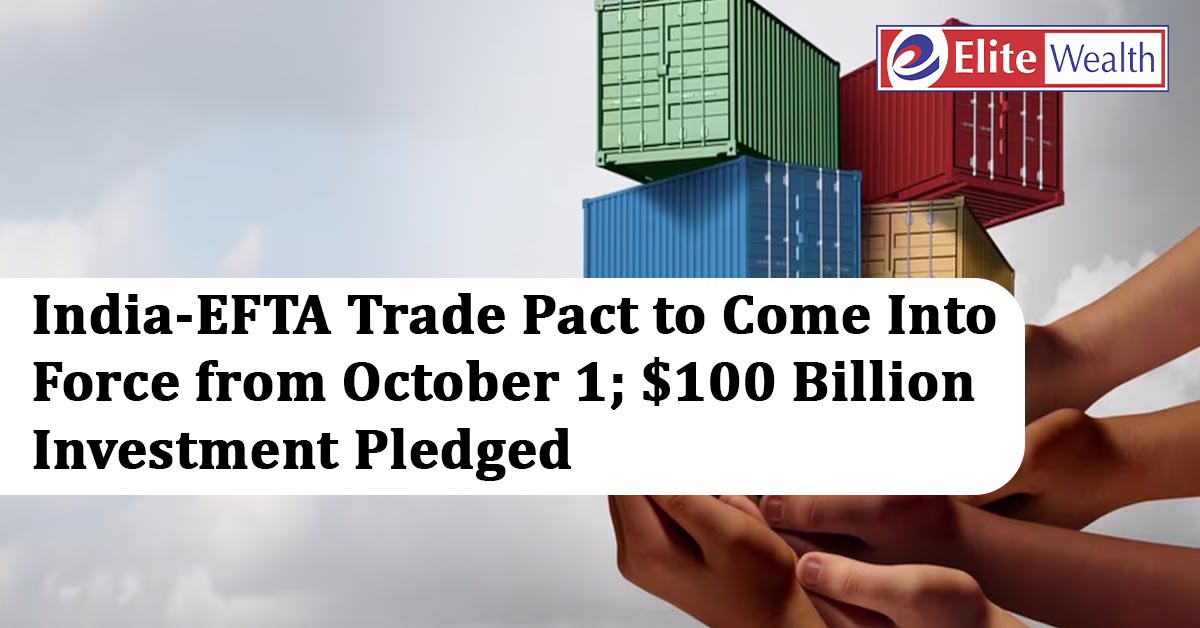
The India-European Free Trade Association (EFTA) Trade and Economic Partnership Agreement (TEPA) is set to come into force on October 1, 2025, marking a milestone in India’s international trade engagements. Signed on March 10, 2024, the pact covers Iceland, Liechtenstein, Norway, and Switzerland, and comes with an unprecedented $100 billion investment commitment over the next 15 years.
Key Highlights of the TEPA
- Investment Commitment: EFTA countries have pledged $50 billion within 10 years and another $50 billion in the following five years, projected to generate one million direct jobs in India.
- Consumer Benefits: Indian consumers will gain access to high-quality Swiss products such as watches, chocolates, biscuits, and clocks at lower prices, as customs duties on these goods will be phased out over 10 years.
- Conditional Provisions: If investments do not materialize as planned, India has the right to rebalance or suspend duty concessions to the four nations.
Trade and Tariff Details
India is offering 82.7% of its tariff lines, covering 95.3% of EFTA exports (with gold accounting for over 80% of imports). Certain sensitive sectors like dairy, soya, coal, and select agricultural products remain excluded.
In the services sector, India has opened 105 sub-sectors to EFTA, including accounting, business, computer, distribution, and health services. Conversely, commitments have been secured from Switzerland (128 sub-sectors), Norway (114), Liechtenstein (107), and Iceland (110). Key growth areas for Indian services include legal, audio-visual, R&D, computer, accounting, and auditing.
Strategic Implications for Indian Industry
The pact presents opportunities for Indian exporters to integrate into EU markets, as over 40% of Switzerland’s global services exports are directed to the EU. According to Gulzar Didwania, Partner, Deloitte India, TEPA enables sectoral synergies:
- Swiss pharma and medical devices complement India’s medical ecosystem.
- Precision machinery and industrial automation from Switzerland and Liechtenstein can bolster Make in India supply chains.
- Norway can support green maritime, offshore wind, and carbon management initiatives.
- Iceland offers expertise in renewable power and geothermal energy for low-carbon industrial solutions.
TEPA is India’s 14th trade deal, its first with developed countries in the Western Hemisphere, and the fifth agreement under the Modi government, following pacts with Mauritius, UAE, UK, and Australia. Ongoing negotiations are in progress with the US, Oman, EU, Chile, New Zealand, and Peru.
Trade and Investment Overview
- India-EFTA trade: In 2024-25, India’s exports to the bloc rose to $1.97 billion, while imports jumped to $22.44 billion, resulting in a $20.47 billion trade deficit.
- Largest partner: Switzerland, with exports of $1.47 billion and imports of $21.8 billion in 2024-25.
- Other EFTA members: Iceland ($66M exports, $11M imports), Liechtenstein ($0.41M exports, $1.82M imports), Norway ($425M exports, $632.8M imports).
- FDI Inflows (April 2000–June 2025): Switzerland ($10.87B), Iceland ($54.07M), Liechtenstein ($110.26M), Norway ($941.81M).
EFTA, not part of the EU, is an intergovernmental organization promoting free trade among its members and serves as an alternative for countries outside the European community.
Summary
India’s Trade and Economic Partnership Agreement (TEPA) with EFTA will come into effect on October 1, 2025, unlocking a $100 billion investment over 15 years and offering Indian consumers lower duties on Swiss products such as watches, chocolates, and clocks. The agreement also opens up 105 service sub-sectors to EFTA and provides a platform for Indian exporters to integrate with EU markets. TEPA represents India’s first trade pact with developed Western countries under the Modi government, signaling new opportunities in investment, technology collaboration, and sustainable industry development.
Disclaimer:
This article is intended solely for educational and informational purposes. The securities or companies mentioned are provided as examples and should not be considered as recommendations. Nothing contained herein constitutes personal financial advice or investment recommendations. Readers are advised to conduct their own research and consult a qualified financial advisor before making any investment decisions.
Investments in securities markets are subject to market risks. Please read all related documents carefully before investing.
